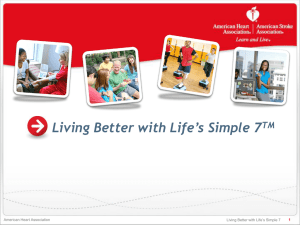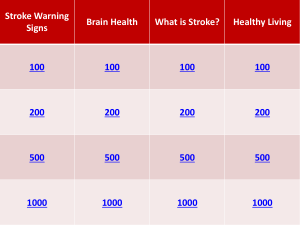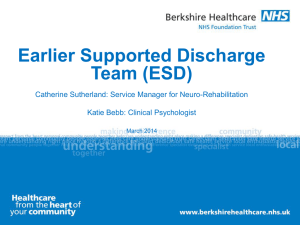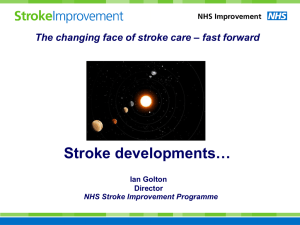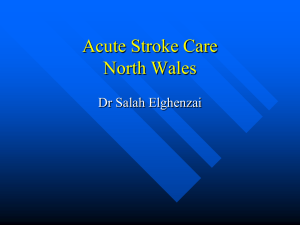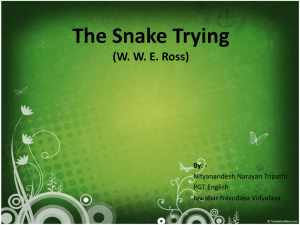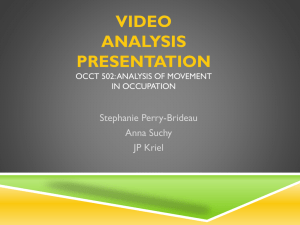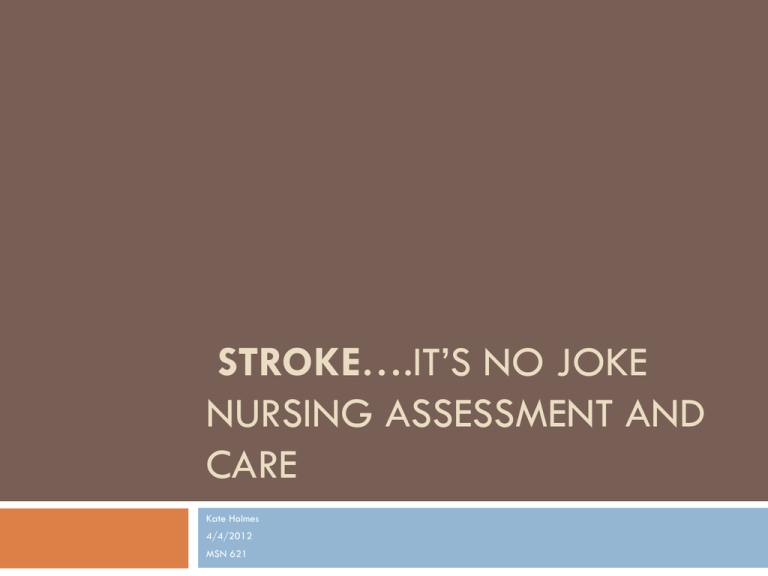
STROKE….IT’S NO JOKE
NURSING ASSESSMENT AND
CARE
Kate Holmes
4/4/2012
MSN 621
Logistics of the Tutorial
Underlined, colored words indicate that the
definition is available. To view these definitions in
context, hover over the link.
Portions of the tutorial are interactive and will
require the learner to click on the appropriate
response which are colored choices located on the
right side of the screen. Pay attention to the bolded
information throughout the case study to help direct
the correct response to these interactive sections.
Links are available to review the case study.
Statistics
Stroke ranks 3rd among all causes of death; behind
heart disease and cancer.
The American Academy of Nurse Practitioners
reports annually that 900,000 patients are
discharged from the hospital with a stroke
diagnosis.
Experts estimate that up to 30% of stroke patients
will deteriorate within the first 24 hours.
American Academy of Nurse Practitioners, 2011
Wild Iris Medical Education, 2010
Objectives
Define a generalized stroke and an ischemic stroke.
Review common stroke risk factors.
Learn the pathophysiology of an ischemic stroke.
Understand the use of the National Institute of
Health (NIH) stroke scale.
Acknowledge the possible Clinical Nurse Specialist
(CNS) role with an acute stroke patient.
Stroke Review
What is a stroke?
A stroke is a disturbance in blood flow to the brain
causing neurological deficits.
Recently titled a “brain attack.”
Microsoft Clip Art, 2010
Case Study
Paul is a 65 year old admitted with stroke like
symptoms. He was brought to the Emergency Room by
his wife who stated “he was acting funny this morning.”
His history and physical reports that he has had
Transient Ischemic Attacks (TIA’s) in the past and is
currently on Coumadin for atrial fibrillation. Paul’s wife
states he stopped taking his Coumadin two weeks ago
because he thought it was the cause of his dizziness. He
has hypertension, is diabetic, obese, and has been
smoking for 40+ years. His father died of a stroke.
Porth & Matfin (2009)
Paul’s risk factors
Modifiable
HTN
Smoking
Diabetes
Cardiac Disease
Obesity
Inactivity
Not Modifiable
Age
Sex
Heredity
Porth &Matfin (2009)
Case Study
In Paul’s case the stroke symptoms are most likely
caused by his uncontrolled atrial fibrillation.
Porth & Matfin (2009)
Used with permission from Linda Bay, Alverno College
Ischemic Stroke Pathophysiology
Patient has atrial
fibrillation.
Heart doesn’t perfuse
blood as forcefully as
normal and therefore
blood flow is slower.
This slow flow leads
to an increase in clot
formation, which tend
to land in the left
atrial appendage of
the heart.
Porth & Matfin (2009)
Ischemic Stroke Pathophysiology
The thrombus
may land in the
left atrial
appendage
causing no real
concern, or
the clot travels
with blood flow
through the
carotid arteries.
The clot will then
land in one of the
cerebral arteries
transporting
blood to the
brain.
When this
happens, there is
a decrease or
depletion of
blood flow to the
brain.
Porth & Matfin (2009)
Ischemic Stroke Pathophysiology
Tissue in the brain
becomes damaged due
to this decrease in
blood flow.
Tissue that may
recover is referred to
as ischemic penumbra
and their recovery is
reliant on how long it
takes the circulation
to improve.
Other tissues die and
this is considered a
stroke; a
BRAIN ATTACK.
Porth & Matfin (2009)
Ischemic Stroke Pathophysiology
Oxygen
and
glucose
are
becoming
depleted
in the
brain
tissue.
There is a
failure in the
production of
phosphate
compounds.
This failure
causes the
cells to
depolarize,
allowing
calcium into
the cell.
The high
levels of
calcium cause
increased
glutamate
levels.
The
mitochondria
break down
and apoptosis
occurs.
Porth & Matfin (2009)
Wikidoc, 2011
Ischemic Stroke Pathophysiology
The immune
system will then
become
activated
causing an
inflammatory
response.
The neutrophils
will be the first
responders and
will release
cytotoxic
compounds.
These
compounds
attract
macrophages,
dendritic cells
and T cells.
Neutrophils
have a short life
span. In the
presence of
inflammation the
body will
decrease
apoptosis in an
effort to
prolong the lives
of the
neutrophils.
Porth & Matfin (2009)
Ischemic Stroke Pathophysiology
The sympathetic
nervous system (SNS)
will then activate,
secreting cortisol.
Cortisol will decrease
the immune and
inflammatory response
to allow more energy
to head to the
emergency.
Corticotrophin
releasing hormone
also helps the stress
response by increasing
blood glucose and
helping the SNS
increase blood
pressure.
Porth & Matfin (2009)
Ischemic Stroke Pathophysiology
The longer the blood
flow is absent or
decreased,
the more brain tissues
die.
This is why
TIME IS BRAIN.
NIH Stroke Scale
Includes assessment of:
Level of Consciousness
Best Gaze
Visual
Facial Palsy
Motor of the Arm
Motor of the Leg
Limb Ataxia
Sensory
Best Language
Dysarthria
Extinction and Inattention
Measures 13 neurological
characteristics of a patient.
The exam takes 5-8 minutes to
complete and should be
completed in the order listed.
Each category is given a score
and the amount totaled at the
end indicates the severity of a
stroke.
NIH Stroke Scale, 2003
Case Study
Paul’s neurological assessment and NIH stroke scale are
as follows:
Paul is alert and responding to your questions.
He states that he doesn’t know what month it is and
reports his age as 30.
He opens and closes his eyes on command, but does
not grip and release his hands.
Based on the above assessment, score the first questions
in the NIH scale by clicking on the correct numerical
score on the following slides.
NIH Stroke Scale – Level of
Consciousness
Level of Consciousness: The
investigator must choose a response,
even if a full evaluation is prevented
by such obstacles as an endotracheal
tube, language barrier, orotracheal
trauma/bandages.
A 3 is scored only if the patient
makes no movement (other than
reflexive posturing) in response to
noxious stimulation.
0 = Alert; keenly responsive.
1 = Not alert, but arousable by
minor stimulation to obey, answer,
or respond.
2 = Not alert, requires repeated
stimulation to attend, or is
obtunded and requires strong or
painful stimulation to make
movements (not stereotyped).
3 = Responds only with reflex
motor or autonomic effects or
totally unresponsive, flaccid, are
flexic.
Review Case Study
NIH Stroke Scale, 2003
That’s right. His score is 0, he is alert and
responding.
Click here to continue.
Try again, Paul is alert and responding.
Click here to try again.
NIH Stroke Scale – Level of
Consciousness - Questions
LOC Questions: The patient is asked
the month and his/her age. The
answer must be correct — there is no
partial credit for being close.
Aphasic and stuporous patients who
do not comprehend the questions will
score a 2.
Patients unable to speak because of
endotracheal intubation, orotracheal
trauma, severe dysarthria from any
cause, language barrier or any other
problem not secondary to aphasia
are given a 1.
It is important that only the initial
answer be graded and that the
examiner not “help” the patient with
verbal or non-verbal cues.
0 = Answers both questions
correctly.
1 = Answers one question
correctly.
2 = Answers neither question
correctly
Review Case Study
NIH Stroke Scale, 2003
Great Job, the answer is 2 because Paul couldn’t
state his correct age or the month.
Click here to continue.
Please try again, he was incorrect with his age and
the month.
Click here to try again.
NIH Stroke Scale – Level of
Consciousness - Commands
LOC Commands: The patient is asked to
open and close the eyes and then to grip
and release the non-paretic hand.
Substitute another one-step command if
the hands cannot be used.
0 = Performs both tasks correctly
1 = Performs one task correctly
2 = Performs neither task correctly
Review Case Study
Credit is given if an unequivocal attempt
is made but not completed due to
weakness.
If the patient does not respond to
command, the task should be
demonstrated to them (pantomime) and
score the result (i.e., follows none, one or
two commands).
Patients with trauma, amputation, or other
physical impediments should be given
suitable one-step commands. Only the
first attempt is scored.
NIH Stroke Scale, 2003
That’s correct. Good work.
Click here to continue.
That’s incorrect. Paul opened his eyes, but did
complete hand grasps on command. He performed
1 task correctly.
Click here to try again.
Case Study
Paul’s pupils are equal with a sluggish reaction.
His gaze follows appropriately.
Paul is unable to follow the visual acuity exam with
both eyes.
Paul raises his eyebrows and closes his eyes without
difficulty.
He follows the command to smile, but a profound
right sided facial droop is noted.
Based on the above assessment pieces, review the next
set of slides to see how Paul would be scored.
NIH Stroke Scale – Best Gaze
Based on the above assessment findings, Paul would
score a 0 on the “best gaze” portion of the NIH
stroke scale because his gaze follows appropriately.
NIH Stroke Scale, 2003
Microsoft Clip Art, 2010
NIH Stroke Scale - Visual
Paul was unable to follow the visual acuity exam
with either eye and therefore his score for this
section of the NIH stroke scale would be 2,
indicating complete hemianopia.
NIH Stroke Scale, 2003
NIH Stroke Scale – Facial Palsy
Paul’s assessment indicates that he has some partial
facial paralysis which would give him a score of 2
in this portion of the NIH stroke scale.
At this point, Paul has a score of
NIH Stroke Scale, 2003
Microsoft Clip Art, 2010
Case Study
Paul’s arms are lifted to a 45 degree angle, his left
arm maintains itself in that position, but his right arm
immediately falls to the bed.
His legs are also lifted and the same situation
arises. He can maintain the lift in the left leg, but
the right leg falls to the bed immediately.
See the following two slides to see how Motor
would be scored according the NIH Stroke Scale.
NIH Stoke Scale – Motor Arm
Motor Arm : The limb is placed in the
appropriate position: extend the arms
(palms down) 90 degrees (if sitting) or
45 degrees (if supine.)
Drift is scored if the arm falls before 10
seconds.
The aphasic patient is encouraged using
urgency in the voice and pantomime but
not noxious stimulation.
Each limb is tested in turn, beginning with
the non-paretic arm.
Only in the case of amputation or joint
fusion at the shoulder or hip may the
score be “9” and the examiner must
clearly write the explanation for scoring
as a “9.”
0 = No drift, leg holds 30 degrees
position for full 5 seconds.
1 = Drift, leg falls by the end of the 5second period but does not hit bed.
2 = Some effort against gravity; leg falls
to bed by 5 seconds, but has some effort
against gravity.
3 = No effort against gravity, leg falls to
bed immediately.
4 = No movement
9 = Amputation, joint fusion explain:
Score for this would be:
Left Arm = 0
Right Arm = 3
NIH Stroke Scale, 2003
NIH Stroke Scale – Motor Leg
Motor Leg: The limb is placed in the
appropriate position: hold the leg at 30
degrees (always tested supine).
Drift is scored if the leg falls before 5 seconds.
The aphasic patient is encouraged using
urgency in the voice and pantomime, but not
noxious stimulation.
Each limb is tested in turn, beginning with the
non-paretic leg. Only in the case of amputation
or joint fusion at the hip, the examiner should
record the score as untestable (UN), and
clearly write the explanation for this choice.
0 = No drift; leg holds 30-degree position for
full 5 seconds.
1 = Drift; leg falls by the end of the 5-second
period but does not hit bed.
2 = Some effort against gravity; leg falls to
bed by 5 seconds, but has some effort against
gravity.
3 = No effort against gravity; leg falls to bed
immediately.
4 = No movement.
UN = Amputation or joint fusion, explain:
____________
Score for this would be:
Left leg = 0
Right Leg = 3
NIH Stroke Scale, 2003
Case Study
Paul is asked to touch his fingers to his nose. He
is unable to follow this command.
He is asked to touch his heels to his shins. He is
also unable to follow this command.
Paul reports feeling and sensation in all
extremities.
Score Paul appropriately based on the above
responses.
NIH Stroke Scale – Limb Ataxia
Limb Ataxia: This item is aimed at finding
evidence of a unilateral cerebellar lesion.
Test with eyes open. In case of visual defect,
ensure testing is done in intact visual field.
The finger-nose-finger and heel-shin tests are
performed on both sides, and ataxia is scored
only if present out of proportion to weakness.
0 = Absent.
1 = Present in one limb.
2 = Present in two limbs.
Ataxia is absent in the patient who cannot
understand or is paralyzed.
UN = Amputation or joint
fusion, explain:
________________
Only in the case of amputation or joint fusion,
the examiner should record the score as
untestable (UN), and clearly write the
explanation for this choice.
In case of blindness, test by having the patient
touch nose from extended arm position.
Review Case Study
NIH Stroke Scale, 2003
Perfect Answer
Click here to continue.
Try that one again. Paul was unable to do either
exam.
Click here to try again.
NIH Stroke Scale - Sensory
Sensory: Sensation or grimace to pinprick when tested,
or withdrawal from noxious stimulus in the obtunded or
aphasic patient.
Only sensory loss attributed to stroke is scored as
abnormal and the examiner should test as many body
areas (arms [not hands], legs, trunk, face) as needed to
accurately check for hemisensory loss.
A score of 2, “severe or total sensory loss,” should only
be given when a severe or total loss of sensation can
be clearly demonstrated.
Stuporous and aphasic patients will, therefore,
probably score 1 or 0. The patient with brainstem
stroke who has bilateral loss of sensation is scored 2.
0 = Normal; no sensory loss.
1 = Mild-to-moderate sensory loss; patient
feels pinprick is less sharp or is dull on the
affected side; or there is a loss of
superficial pain with pinprick, but patient is
aware of being touched.
2 = Severe to total sensory loss; patient is
not aware of being touched in the face,
arm, and leg
If the patient does not respond and is quadriplegic,
score 2. Patients in a coma (item 1a=3) are
automatically given a 2 on this item.
Review Case Study
NIH Stroke Scale, 2003
You’re an expert.
Click here to continue.
That is the wrong score, Paul reported a feeling of
sensation in all his extremities.
Click here to try again.
NIH Stroke Scale – Best Language
Best Language: A great deal of information
about comprehension will be obtained during
the preceding sections of the examination.
For this scale item, the patient is asked to
describe what is happening in the attached
picture, to name the items on the attached
naming sheet and to read from the attached list
of sentences.
Comprehension is judged from responses here,
as well as to all of the commands in the
preceding general neurological exam.
If visual loss interferes with the tests, ask the
patient to identify objects placed in the hand,
repeat, and produce speech.
The intubated patient should be asked to write.
The patient in a coma (item 1a=3) will
automatically score 3 on this item.
The examiner must choose a score for the
patient with stupor or limited cooperation, but
a score of 3 should be used only if the patient
is mute and follows no one-step commands.
0 = No aphasia; normal.
1 = Mild-to-moderate aphasia; some obvious
loss of fluency or facility of comprehension,
without significant limitation on ideas expressed
or form of expression. Reduction of speech
and/or comprehension, however, makes
conversation about provided materials difficult
or impossible. For example, in conversation
about provided materials, examiner can
identify picture or naming card content from
patient’s response.
2 = Severe aphasia; all communication is
through fragmentary expression; great need
for inference, questioning, and guessing by the
listener. Range of information that can be
exchanged is limited; listener carries burden of
communication. Examiner cannot identify
materials provided from patient response.
3 = Mute, global aphasia; no usable speech or
auditory comprehension.
NIH Stroke Scale, 2003
NIH Stroke Scale – Best Language
Paul is asked to explain
what is happening with
this picture.
He responds….. “water
is coming from the
cupboards. Oh boy
that’s awful……look at
those children, they are
cute.”
What’s his score?
0
1
2
3
NIH Stroke Scale, 2003
Nice job!!!!
Click here to continue.
Try again.
Click here to try again.
NIH Stroke Scale – Best Language
Paul is asked to name the
items below.
He responds that he
sees his gardening
glove, and a hammock.
He comments that the
chair looks comfortable.
What’s his score?
0
1
2
3
NIH Stroke Scale, 2003
That’s right.
Click here to continue.
Sorry, that’s incorrect.
Click here to try again.
NIH Stroke Scale – Best Language
Paul is asked to read the
following sentences.
You know how.
Down to earth.
I got home from work.
Near the table in the dining
room.
They heard him speak on the
radio last night.
He responds, “oh…that’s silly.
You know I can read.”
When asked again to read
the sentences, Paul stares at
the words, but cannot
verbalize what he is reading.
What’s his score?
0
1
2
3
NIH Stroke Scale, 2003
Perfect answer.
Click here to continue.
Give it another shot.
Click here to try again.
NIH Stroke Scale - Dysarthria
Paul is asked to repeat
the words below.
Mama
Tip –Top
Fifty-Fifty
Thanks
Huckleberry
Baseball Player
He repeats some of the
words clearly, but others
are difficult to
understand.
Based on Paul’s
response, he would be a
given a 1 for this area
of the NIH stroke scale.
NIH Stroke Scale, 2003
NIH Stroke Scale – Extinction and
Inattention
The final category or the NIH stroke scale gave Paul
a score of 1.
After completing the NIH stroke scale, Paul has a
total score of 18.
What does this mean?
NIH Stroke Scale, 2003
NIH Stroke Scale
The NIH Stroke Scale is helpful in measuring the
severity of a stroke and is also helpful in evaluating
improvement or worsening of an acute stroke
patient.
The score can range from 0-42. The higher the
score, the more severe the neurological injury.
A score of 10 or greater gives a patient a less
likely chance for a good recovery.
A score over 22 is considered a major stroke.
NIH Stroke Scale, 2003
Wild Iris Medical Education, 2010
APN CNS Role
Paul is admitted to the Intensive Care Unit for
further monitoring. You, are a CNS on that unit and
are aware of his arrival.
As a CNS just spell out STROKES to put it all
together.
Microsoft Clip Art, 2010
APRN role
S
Teaching and coaching nurses on strokes
Research and application of best practice
Other disciplines…..Collaboration for the patient
tay in Consultation from admit to discharge
Knowledge and Clinical Expertise of stroke care
Ethical decision making when the case gets complex
Skills in Leadership
Hamric, Spross, and Hanson (2009)
CNS Role
The
spheres of
influence.
Nursing
System
Patient
Hamric et al. (2009)
Summary
Throughout this tutorial you should have learned.
How
to define a generalized and ischemic stroke.
What the risk factors of a stroke are.
The pathophysiology of an ischemic stroke.
Understanding of the NIH stroke scale.
Review of the CNS core competencies and spheres of
influence.
Literature Cited
Hamric, A.B., Spross, J.A., & Hanson, C.M. (2009). Advanced practice nursing: An integrative approach (4th ed).
St. Louis, MO: Elsevier Saunders.
Bergman, D. (2011). Preventing recurrent cerebrovascular events in patients with stroke or transient ischemic
attack: The current data. Journal of the American Academy of Nurse Practitioners, 23 (2011), 659-666. doi:
10.1037/0278-6133.24.2.225.
Katz, M.J. (2010). Stroke ICU and potential complications. Wild Iris Medical Education. Retrieved from
http://www.nursingceu.com/courses/328/indexx_nceu.html
Gibson, C.M., (2011). Stroke Pathophysiology. Wikidoc. Retrieved from
http://www.wikidoc.org/index.php/Stroke_pathophysiology
National Institute of Health Stroke Scale (NIHSS). (2003). NIH Stroke Scale. Retrieved from
http://www.nihstrokescale.org/
Porth, C.M. & Matfin, G. (2009). Pathophysiology: Concepts of altered health states (8th ed). Philadelphia:
Lippincott, Williams, & Wilkins.


